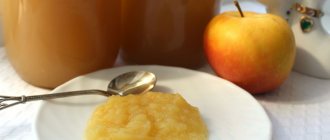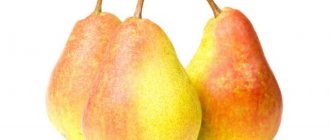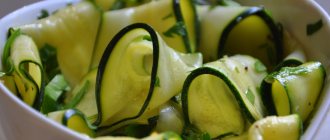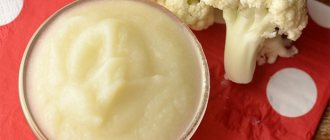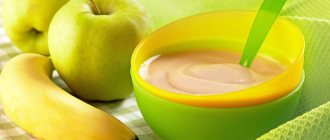Introduction of squash complementary foods in winter
Not all children are born in winter, so that with the onset of warmth they can receive delicious complementary food from fresh zucchini.
Making puree from produce from the garden is ideal. But what to do if the baby turns six months old in winter? In supermarkets you can now find almost any fresh vegetables and fruits brought from southern countries. But during transportation they retain a minimum of natural substances, and the methods of their cultivation make one doubt the benefits of the product. Experienced mothers know how to prepare zucchini for the first complementary foods for the winter. The method is simple - freezing.
Products from the freezer, prepared in the summer, have long been an excellent solution to provide yourself and your family with vitamins during the cold season. Frozen zucchini was no exception. The product retains all its beneficial properties, and after defrosting it does not lose its taste. Before sending to the freezer, the zucchini is washed and dried, cut into circles and placed in a single layer in freezer bags. There is no need to make large preparations, because defrosting and re-freezing does not have the best effect on the taste and beneficial properties of the product.
There is no need to defrost the zucchini to prepare it. They are immediately placed in boiling water and cooked for 10-15 minutes until soft. Purees from frozen foods have a more watery consistency, but this does not reduce the beneficial qualities. Zucchini from the freezer will be the best option for preparing tasty and healthy purees for your baby in the winter.
Recipe two - frozen zucchini puree
People often prepare zucchini in advance and freeze it as a reserve for the winter. There is also a corresponding recipe for the winter:
See also: A simple and tasty recipe for making pickled butter for the winter at homeRead
- Do not defrost the product so as not to get porridge. Just add water and cook for up to 10 minutes.
- Check for doneness. Remember and rub through a sieve.
- Serve to the table!
You can cook frozen vegetables in a double boiler or slow cooker - choose the most suitable option. The cooking method does not affect the taste of the dish or the content of vitamins in the composition.
After cooking, if the dish is intended for infants, it is necessary to flavor the puree with breast milk, because freezing slightly changes the natural taste of the vegetable. Children's doctors do not recommend adding salt or adding sugar.
Cooking methods
To prepare the puree, you need to boil the zucchini; this can be done on the stove, in a slow cooker, or in a double boiler. The cooking procedure is as follows:
- Boil peeled and chopped zucchini in any convenient way;
- grind using a blender, masher, sieve, grater or regular fork;
- if there are additional ingredients, cook them too, chop and mix with the zucchini;
- add milk, cream or butter.
Separately, it is worth considering each method of preparing the zucchini itself.
On the stove
This method is simple and familiar, but it is believed that too many useful substances are lost into the water during cooking. Cook zucchini for puree like this:
- Pour water into a saucepan and bring to a boil on the stove;
- cut the zucchini into large pieces;
- add to boiling water;
- cook for 10-15 minutes;
- place the zucchini in a colander;
- grind using any of the above methods.
For a couple
The most useful method, which preserves the maximum amount of vitamins. For cooking, use a double boiler; just place the zucchini in the bowl and turn on the “cook vegetables” mode for 10 minutes.
If you don’t have such equipment in your kitchen, you can build a steamer yourself using a saucepan and a colander. For this:
- pour water into the pan;
- place a colander with chopped and peeled zucchini on top;
- turn on the heat and bring the water to a boil;
- Cover the colander with a lid;
- cook until squash is soft, 15-20 minutes.
In a frying pan
You can stew the zucchini for puree in a frying pan in its own juice:
- wash and peel the zucchini;
- cut into cubes;
- place in a frying pan and cover with a lid;
- simmer over medium heat for 20-25 minutes.
In a slow cooker
It’s very easy to prepare healthy zucchini puree in a slow cooker, especially if it has a “steam” mode:
- Place the prepared and chopped zucchini in a container for steaming;
- place on a wire rack;
- set the “steaming” mode;
- cook for 15-20 minutes.
Recipes for making zucchini puree
Dish for dinner
600 grams of zucchini are peeled and cut into cubes or cubes. Sliced vegetables are placed in boiling water so that the liquid lightly covers the pieces. Cooking time – 10 minutes.
While the zucchini is cooking, prepare the vegetable frying. Heat vegetable oil in a frying pan and fry the diced onion. Then grated carrots are added to it. As soon as the carrots soften, add two finely chopped cloves of garlic to the frying. The garlic pieces are only slightly heated, achieving a strong aroma. Immediately add a tablespoon of tomato paste to the vegetables and keep the pan on the fire for another minute.
Place the softened zucchini first on a sieve to drain excess moisture, and then into a blender bowl. Add fried vegetables, salt and a couple of pinches of ground black pepper to the boiled vegetables. Punch the mixture until smooth, and then heat it again in a frying pan.
The finished puree is served as a side dish for any meat or fish dishes.
A video from the channel “Gala Rada / Fast Kitchen” will tell you how to prepare zucchini puree in a slow cooker.
Zucchini puree for children
First feeding from zucchini
For children over two years old, puree can be prepared according to the recipe described above. It is only recommended to reduce or completely eliminate garlic and black pepper from the ingredients.
How to properly cook zucchini
The life of a modern parent makes a lot easier. For example, if in the past mothers had to do everything themselves, today there are many manufacturers of baby food. Jars of already ground vegetables, fruits, and meat are sold in stores and given out in dairy kitchens. It is better to use them during the off-season, in winter. Many people still prefer to make their own meals. It will be useful for such mothers to learn how to prepare zucchini puree for babies at home.
Mom prepares puree for baby
How long to cook
Zucchini can be eaten in any form: its peel, seeds, pulp, even raw, can be eaten by adults. The baby needs to boil the vegetable. Otherwise, if it is too hard, it will harm your tummy. The first question that a young mother will face is how much to cook zucchini for complementary feeding.
The structure of the vegetable is not particularly dense. It is soft in itself, very watery. Therefore, it does not require long boiling, like pumpkin, for example. To cook it, it will be enough to keep the pieces in boiling water for 10 minutes.
Note! Thermal treatment can be any type, as long as it does not require cooking in oil and does not dry out the zucchini. That is, you can cook zucchini for the first feeding either in a saucepan or in a slow cooker
You can also steam it in a double boiler. In any case, it will also only take about 10 minutes of cooking.
Puree recipe
There is nothing difficult in preparing zucchini puree, especially considering that it is usually prepared with a blender. However, even if there is no such device in the kitchen, you can get by with a simple masher. To ensure that no problems arise, the recipe for making zucchini puree for the first feeding is described below step by step. The hostess will simply have to comply with it.
To start cooking, you need to prepare the vegetable itself. Zucchini, like any other product, is introduced into the diet gradually: starting with one spoon and increasing to a 100-200 gram portion. In this case, the puree is not stored for longer than a day. Therefore, you should take from 20 to 200 grams of vegetables for cooking, depending on the stage of complementary feeding, no more. The preparation itself looks like this:
- The vegetable is washed, cleared of seeds and tail. Moreover, the smallest seeds do not need to be removed if you later puree the zucchini using a blender. If you only have a potato masher, remove all the seeds. The peel does not need to be peeled.
- The zucchini is crushed and cut into round pieces (not very thin, about 1 cm thick).
- Pour some water into a small saucepan or saucepan. Vegetable pieces are placed there. There is no need to add salt to the water - salt is contraindicated for children. If cooked in a slow cooker or double boiler, then add as much water as required by the operating instructions.
Steamed zucchini
- After heat treatment, the zucchini can be transferred to a clean container and pureed using a blender or masher.
- The last step of the baby zucchini puree recipe is a little olive oil, which is added to the vegetable mass. For the first servings, 1 teaspoon will be enough. Per serving up to 50 g. pour in 0.5 tsp by weight. oils, from 50 to 100 gr. – 1 tsp.
After these steps, the puree will only need to cool a little. Then you can feed the baby with it.
Zucchini puree for the winter for children: recipes on how to prepare with photos and videos
Zucchini is a vegetable loved by many people. This is not surprising, because its versatility is amazing: suitable for both baby food and daily use by adults. One of the popular recipes is zucchini puree.
general information
Before you start preparing zucchini puree for the winter, you need to choose the right ingredients. Everything is quite simple, because both young and old vegetables are suitable. However, if you are preparing zucchini puree for infants or older children, you will need to thoroughly clean the zucchini. The most convenient way to do this is with a vegetable peeler, and the seeds can simply be removed with a regular spoon.
To prepare the zucchini, you need to cut it into pieces no more than 2 cm thick. You can cut it into cubes, semicircles, circles - whatever is convenient.
Recipe one - zucchini puree for the winter
The dish is quite easy and quick to prepare. We advise you to try making zucchini puree for children - they will definitely like it. The vegetable is easily digestible and has excellent taste.
For preparation you will need:
- vegetable - 2 pieces;
- salt - to taste.
The number of servings is about 10.
- Peel the zucchini and remove the seeds.
- Let's cut it.
- Place the pieces in slightly salted water. You need to cook over low heat for at least a quarter of an hour. Then let it cool.
- We prepare jars and lids for screwing and sterilize.
- Place the mixture in a blender, or you can use a food processor. You should get a homogeneous mass.
- Place the puree in jars and sterilize for 5 minutes, roll up and put in a cool place.
Preparing such zucchini for the winter is not at all difficult. Puree for babies is an excellent complementary food. You need to start with small portions, taking into account the recommendations of a specialist.
Zucchini is an easily digestible and healthy product for children. You can add cabbage, carrots or other boiled vegetables to the recipe, but watch your baby's reaction.
Recipe two - frozen zucchini puree
People often prepare zucchini in advance and freeze it as a reserve for the winter. There is also a corresponding recipe for the winter:
Recipe 7. Zucchini puree for children over 1 year old
– Zucchini - 1 piece
– Potatoes – 2 pieces
– Milk – 0.5 cups
– Olive oil – 1 tsp.
– Lemon juice – 1 tsp.
– Quail egg – 1 piece.
Wash the potatoes and zucchini thoroughly, peel them and cut them into cubes. Place the vegetables in a saucepan and pour boiling water until the water completely covers them. Place on the fire, bring to a boil and continue cooking over low heat for 20 minutes. Pass the cooked vegetables through a sieve.
Boil a quail egg in a separate pan, peel it and remove the yolk. Grind it with a fork and add it to the vegetable puree. Beat everything with a blender and add salt to taste.
Zucchini puree for children for the winter
Composition (per 0.6–0.7 l):
- zucchini – 1 kg;
- water – 0.25 l;
- salt (optional) – 3 g.
Cooking method:
- Wash the zucchini thoroughly, remove the peel and large seeds. Cut the squash pulp into small cubes and place in a saucepan. Pour a glass of water into it and place it on the stove.
- Bring the water to a boil over low heat and simmer the zucchini, covered, until they become soft.
- Drain in a colander to remove excess liquid.
- Cool the boiled zucchini slightly, place in a blender bowl, and grind until pureed.
- Mix the puree with salt if you decide to add it.
- Place on low heat, cook for 5 minutes.
- Wash with soda and sterilize the jars and matching lids. For baby food, it is better to use small jars, since after opening the puree can only be stored in the refrigerator and for no more than 24 hours.
- Fill the jars with zucchini puree and cover them with clean lids.
- Place a towel on the bottom of the pan and place jars of puree on it.
- Over low heat, bring the water in a saucepan to a boil, sterilize the jars in it for 5 minutes if their volume does not exceed 0.2 liters, 10 minutes if their volume does not exceed 0.5 liters. For jars of larger volume, the sterilization time will have to be increased, but it is not advisable to seal baby puree in them.
- Remove the jars of squash puree from the water and seal them tightly.
- Turn the jars over, cover with a blanket and leave like that for 12 hours.
After the specified time, the jars of puree must be placed in the refrigerator or cool room. They can be stored for six months.
This is interesting: Poppy pie in a slow cooker: recipe and photo
Zucchini puree for the winter
Zucchini is very good for health. They are rich in various minerals and are ideal for dietary and baby food. Zucchini is safe for small children and is recommended by doctors for the baby's initial complementary feeding. They have a very good effect on the intestines and help children restore stool. To prepare dishes for children, you need to choose small young zucchini with thin skin.
Wash the zucchini, clean it, remove the seeds,
cut into small pieces.
Then there are two options for preparing puree.
The first method of preparing zucchini puree for the winter
Place the zucchini in a colander and place it in boiling water. Cover the lid and cook for 10 minutes.
We take out a colander and wait for the water to drain. Wipe with a fork or blender.
The second method of preparing zucchini puree for the winter
Place the zucchini pieces in a saucepan, add a little water and cook after boiling for 10 minutes.
Let's warm up.
With this option, the puree is lighter. If zucchini puree is prepared for the first feeding, it is better not to add salt or sugar. And if for older kids, you can add salt to taste, garnish with chopped boiled eggs, herbs, add sour cream or butter.
You can freeze zucchini and cook puree from them in winter . Prepare the vegetables as described above, cut them into pieces or grate them. Place in a container or bag and put in the freezer. There are also many recipes for canning zucchini.
The following recipes are suitable for children:
1. Make zucchini puree (using one of the methods listed above) depending on the age of the child or your desires
2. Add fried onions and carrots, salt and sugar to taste, concentrated acetic acid (at the rate of 0.5 tsp per 1 liter). Mix everything.
3. Place the puree into sterilized jars, place them in a pan with water and sterilize for another 10-15 minutes in boiling water.
4. Roll up the jars and leave the lids down until they cool completely. Store in a cool place.
Another zucchini puree recipe
1. Prepare the zucchini. Cut into pieces. Blanch for 5 minutes in boiling water.
2. Place in sterilized jars. Fill with brine (3 tablespoons of sugar, 1 tablespoon of salt per 1 liter).
Because These preparations are intended for children; I do not recommend getting carried away with spices . You can add bell pepper, carrots, dill, parsley. Before closing the jar, add concentrated acetic acid to it (at the rate of 0.5 tsp per 1 liter).
Despite the fact that zucchini dishes are simple and affordable, they have a wonderful taste and a lot of useful properties.
Freezing zucchini
You can prepare zucchini for the winter by freezing. You will need to store vegetables in the freezer.
Preparing vegetables for freezing is easy. The zucchini needs to be washed well; if they are not very young, they will have to be cleaned of seeds and peel. Then the zucchini is cut into pieces of the desired shape. You can freeze zucchini:
- in circles (only young vegetables);
- cubes or sticks;
- grated.
If you want to serve fried zucchini in the winter, use them for sandwiches and pizza, then freeze the vegetables in mugs. There is no need to cut it too thin; the mugs should be about 1 cm thick. Before freezing, it is recommended to blanch the zucchini mugs by dipping the mugs in boiling water for 5 minutes. Then let the vegetables dry and place them on a tray or board covered with cling film, and also cover the top with film. Place in the freezer. When the mugs are frozen, they can be transferred to a bag or container.
Freezing zucchini into cubes is an excellent option for preparing stews, soups, caviar and other dishes. To make the preparation successful, it is recommended to blanch the sliced zucchini. Place the vegetables in a colander and place it in a pan of boiling water so that the bottom of the colander does not come into contact with the water. Steam the zucchini for 5 minutes. Then remove the colander and immerse it in a large container of cold water. Dry the vegetables thoroughly. Place in a thin layer in a bag and place in the freezer.
If you like zucchini pancakes, then it makes sense to freeze grated zucchini. Grate the zucchini, let it stand for 10 minutes. After that, squeeze it out and arrange it into pacts. Place the bags in the freezer and store there until ready to use.
Making zucchini puree
Step 1: Prepare the zucchini.
Wash the zucchini and cut off the ends. If your vegetables are fresh and young, with thin skin, then you do not need to peel it, but if the zucchini has already been sitting and its skin has become rough, you need to remove it with a knife. Cut the washed and peeled vegetables into circles of medium thickness. This is an important point because thin slices may fall apart during cooking, and thick ones will not cook through.
Step 2: Prepare the zucchini.
Pour cool water into a saucepan and place it over high heat to bring to a boil. Next, place a steaming rack on top of the pan and place the zucchini pieces in it. Make sure the water is boiling all the time. Cook the zucchini in this manner for 10-12 minutes or until they are soft.
Step 3: Prepare the garlic.
Peel the garlic cloves and cut off the ends. Divide each into three to four parts so that the pieces are not too small and do not fry in the process. Melt a little butter in a frying pan and fry the chopped garlic cloves in it. Cook this ingredient just a little, just until it begins to turn golden brown and emit a fragrant smell.
Step 4: Prepare the puree.
Place steamed pieces of zucchini, fried garlic into a blender bowl, add salt and pepper to taste, and then pour in a little chicken broth
Important: do not pour out all the broth at once, add it gradually so as not to make the puree too thick or, on the contrary, too thin. Mix all ingredients in a blender, turning the vegetables into a homogeneous mass. That's it, the puree is ready! Make sure you add enough spices to it and go serve your culinary creation on the dinner table
That's it, the puree is ready! Make sure you add enough spices to it and go serve your culinary creation on the dinner table.
Step 5: Serve the zucchini puree.
Serve the zucchini puree hot as a side dish, just as you would serve mashed potatoes. Enjoy a tasty and very healthy addition to the main dish, and then be surprised by the lightness that forms in your stomach after this wonderful dish. Bon appetit!
Tips for the recipe:
– This is a seasonal dish, which it is advisable to prepare from fresh zucchini, picked straight from the garden, if you have such an opportunity.
– Zucchini puree can also be combined with cauliflower, potatoes or carrots. These vegetables also need to be steamed first, and then chopped together with the zucchini.
– Zucchini puree is very useful for children, but you need to prepare this dish for your little gourmets with less garlic and ground black pepper or without them at all.
How and when can it be introduced into complementary foods?
Pediatricians recommend starting complementary feeding for children who are prone to constipation with zucchini. They are easily absorbed and digested and do not create a large burden on the digestive system. They contain vitamins B, A, K, E, C, as well as trace elements magnesium, potassium, copper, phosphorus, and iron.
These substances ensure the maintenance of the balance of water and salt in the body. The vegetable has general strengthening, antianemic and choleretic properties. It also has a beneficial effect on heart function, the condition of nerve and muscle fibers, and cerebral circulation. Moreover, the product is hypoallergenic.
Artificial children can be given zucchini from the age of 4-5 months. Breastfed babies should introduce vegetables into their diet from six months. Many young, inexperienced mothers do not know how to prepare zucchini for feeding their baby.
Rules for introducing vegetable crumbs into the diet:
- For the first time, give the product in a minimal amount (half a teaspoon) and observe the reaction of the baby’s body. If diarrhea, flatulence, rashes on the body and other negative reactions do not occur within two days, then the single serving can be gradually (over the course of a week) increased to 170 g;
- Offer zucchini to the child before taking mother’s milk or an adapted formula;
- It is better to give a new product in the first half of the day;
- Vegetables for complementary feeding must be freshly prepared. It should be offered to the baby warm;
- the dish for the first feeding should be one-component.
Zucchini, like other foods, should be introduced into complementary foods provided that the child has not suffered any illnesses or vaccinations over the past two weeks.
All varieties of zucchini, including zucchini, are healthy and allowed for children. The main thing is that the vegetable is of high quality and safe. It’s good if you have your own garden bed where zucchini grows. You can be sure of the quality of such a product.
Vegetables sold at markets and supermarkets are often stored in inappropriate conditions. Therefore, there is a risk of purchasing a damaged product. When growing, out-of-season greenhouse zucchini is fertilized. Such a product can be dangerous to the health of the baby. It is important to know the rules for choosing quality zucchini.
Experts advise paying attention to the following when purchasing:
- freshness. The vegetable should be firm, without rotten areas. It is important that pressure does not leave any dents;
- size. You should not take fruits that are too large. They may contain fertilizers, be overripe;
- appearance. The peel of a quality product is shiny, without scratches or cuts. Uneven color is allowed;
- degree of maturity. When feeding a baby, you should give preference to young zucchini. They have juicier and more tender flesh.
Preparing zucchini for your baby is quick and easy. The vegetable is peeled and seeds removed, washed, cut into pieces and boiled in a small amount of water until soft. Readiness can be checked with a fork or knife. The zucchini should be easy to pierce and not fall apart or turn into mush when pressed.
Cooking time depends on the degree of ripeness of the fruit and the size of the pieces. If the vegetable is young, it will be ready 5-7 minutes after the water boils. Ripe fruit may need 15 minutes or more. The boiled vegetable is pureed using a blender or mashed with a fork.
There are many different healthy zucchini dishes. You can make puree, soup, casserole, and cutlets from this vegetable.
Many young mothers don’t know whether to add salt to their baby’s food. Evgeniy Olegovich Komarovsky advises adding salt to dishes no earlier than one year of age.
Classic zucchini puree is an ideal option for baby's first complementary foods. To prepare it, use about 100 grams of vegetables. The fruit is peeled and cut into small cubes. Dip into water and cook until tender. Grind in a blender until pureed.
If the mass is too thick, then it should be diluted with expressed breast milk or an adapted formula. From 7-8 months of age, you can add a little vegetable oil to your baby’s purees. This increases the beneficial properties of the dish.
You can make a little puree from zucchini and apples. Products must be peeled and seeds removed and cut into slices.
Pour a glass of water into the multicooker. Place pieces of fruit and vegetables in a steamer basket. Select the “steaming” mode and set the time for 15 minutes. You can simply boil the ingredients in a pan of water. The finished ingredients should be transferred to a blender container and blended until smooth.
From the age of eight months, you can offer your baby tender vegetable puree. To prepare it you will need half a zucchini and carrots, two medium potato tubers, a teaspoon of olive oil. Vegetables need to be peeled, washed, cut into pieces and boiled for 20 minutes. Combine the finished ingredients and beat with a blender or rub with a spoon through a sieve. Fill with oil.
Zucchini puree
We invite you to familiarize yourself with the DIY children's playground: 800 photos, step-by-step instructions || Do-it-yourself airplane for the playground
For a child over 9-10 months of age, you can prepare a dish of zucchini and turkey or chicken fillet. You will need one young vegetable, 50 g of meat and 3 ml of vegetable oil. The zucchini needs to be peeled and seeded, cut into pieces, filled with water and put on fire.
Separately boil the poultry fillet. Combine the finished ingredients and bring them with a blender to a homogeneous puree. Add vegetable oil and stir.
Soups for complementary feeding should be included in the child’s menu from 7 months, after becoming familiar with vegetables. They are prepared from those products that are well accepted by the child’s body. Recipes for tasty and healthy soups for children are given in the table.
Zucchini cream soup
| Name | Ingredients | Cooking algorithm |
| Zucchini and cauliflower soup |
| Boil the vegetables until tender. Remove them from the water and grind them with a blender or mash with a fork. Dilute with broth to desired consistency. Add butter and stir. |
| Puree soup of zucchini, carrots and potatoes |
| Peel the vegetables, rinse and cut into pieces. Place a saucepan with water on the fire. When the liquid boils, you should lower the carrots, and then the potatoes and zucchini. At the end add chopped herbs. Let the soup brew for half an hour. Remove the vegetables and puree them in a blender. Dilute with broth to desired consistency. Add vegetable oil and stir. |
Casserole
Chop the greens. Peel the zucchini and remove seeds and grate it on a fine grater. Add rice and herbs to it. Beat in the egg. Add salt and mix. Grease the frying pan with butter.
Pour in the mixture and smooth it out with a spoon. Place in the oven for 25-35 minutes.
Vegetable cutlets
You can prepare vegetable cutlets for your baby. You will need carrots, cauliflower, zucchini, green peas and semolina in equal parts. Vegetables should be washed, peeled and chopped in a blender. Add semolina and add salt. Wait about 15-20 minutes until the cereal swells. Form cutlets, roll them in flour and steam for about 5-7 minutes.
Young zucchini does not last long. If you want to pamper your baby with a vegetable dish in late autumn, winter or spring, you can try freezing the fruits. At low temperatures, all the beneficial properties of the product are preserved.
But you need to know how to freeze zucchini correctly.
The fruit should be washed, dried, peeled and cut into slices about 3 cm thick. Place the pieces in a plastic bag in one layer.
Set the temperature in the freezer to the lowest possible value.
After 30 minutes, place the packed zucchini slices into the chamber. After an hour, return to the usual temperature.
Thus, you can make baby purees, soups, casseroles, and cutlets from zucchini. It is important to choose high-quality and young fruits. To be able to pamper your baby with a delicious vegetable dish in winter, you should take care of freezing the zucchini in advance.
Zucchini puree in a slow cooker
Composition (per 2 l):
- zucchini – 3.5 kg;
- tomato paste – 0.25 l;
- salt – 20 g;
- sugar – 20 g;
- table vinegar (9 percent) – 40 ml;
- garlic (optional) - to taste.
Cooking method:
- Cut the peeled and seeded zucchini into small pieces and grind through a meat grinder.
- Mix with tomato paste, salt and sugar. Place in the multicooker bowl.
- Turn on the unit by selecting the “Extinguishing” program, set the timer for an hour.
- 5 minutes before readiness, add the garlic passed through a press.
- After the program completes, add vinegar to the puree and stir the mixture.
- Place the puree into prepared jars and close them tightly.
The puree prepared according to this recipe stands well at room temperature. The minimum shelf life of these canned foods is 1 year.
Zucchini puree is more tender than zucchini caviar and is a more healthy product. Puree recipes for children and adults differ, but they are all quite simple.
Selection and preliminary preparation of vegetables
Some tips for choosing vegetables, which, if followed, will result in a healthy and tasty puree for your baby:
- It is preferable to buy vegetables from a trusted manufacturer if you cannot grow them yourself. They are more likely to be environmentally friendly. Commercially grown zucchini may contain nitrates and other chemicals.
- The fruits must be washed and the tail removed.
- Regarding peeling vegetables. It is cleared in two cases. If purchased from unknown manufacturers, chemicals that were added to the soil during cultivation or sprayed accumulate in the skin. If the zucchini is very ripe, it is necessary to peel the skin and remove the seeds, otherwise you will not get a completely homogeneous mass and pieces of the skin will come across.
- The vegetable is cut into pieces before heat treatment.
Simple recipes for pickled cucumbers for the winter Bulgaria is on vacation and preserved storage
Read
The benefits of zucchini for a child
The benefits of this green vegetable, whether for children or adults, are difficult to overestimate. It has the following properties:
- Easy to digest. This is what is needed for a baby who only yesterday knew only one food - milk;
- Does not irritate the intestinal mucosa;
- Cleanses the body of debris: toxins, waste;
- Improves digestion. It contains a lot of fiber, which helps prevent constipation;
- Low likelihood of allergies. A reaction to this vegetable is extremely rare;
- Strengthens the immune system. The body resists viruses and diseases better.
- Takes care of the heart, supports its proper development;
- Helps to properly develop the visual system;
- Indicated for anemia.
Zucchini is best suited for first feeding because it easily breaks down in the stomach and intestines without injuring them, and also because it is low allergenic. It is one of the “starting five” vegetables recommended for children by WHO.
Composition and nutritional value
Its composition is responsible for this effect of zucchini. It contains many useful microelements, namely:
- Vitamin complex (A, C, group B, E, PP);
- Calcium;
- Magnesium;
- Iron;
- Potassium;
- Pectin;
- Natural sugar;
- Cellulose.
https://youtube.com/watch?v=YSuMI61ZRzc
Zucchini puree for babies - the first food for the baby
The baby is growing up, and his mother’s milk - so tasty and nutritious - is no longer enough for him. When it comes to introducing the first complementary foods, one of the dishes popular with pediatricians and children's nutritionists is zucchini puree for babies. It is this vegetable that has properties that are so suitable to allow it to become the first independent food of a small child.
Zucchini is a hypoallergenic product, it stimulates digestion, does not cause bloating, and prevents constipation. Zucchini is also rich in microelements and vitamins, such as:
Zucchini is quick and easy to prepare, which will appeal to any mother who knows the value of every minute of free time. Of course, you can buy zucchini puree for babies, packaged in jars, in the children's section of the store, but many mothers prepare it at home on their own. Some people are not sure about the cleanliness of the production process, some people feel sorry for paying a lot of money for multi-colored jars, and some people have an excess of zucchini in their garden. Some mothers simply like to prepare food for their child themselves.
Zucchini puree - my first “puree”
For a bottle-fed child or an infant who is slightly underweight, the doctor may recommend introducing complementary foods from 4.5-5 months. If the mother continues to breastfeed, then there is no need to introduce complementary foods until six months. From six months you can already try giving your baby vegetable and fruit purees. You should start complementary feeding with vegetable purees, since if the child tries a sweeter fruit puree, then after that he may refuse vegetable purees. That is why zucchini puree for babies takes a leading place among the products recommended for starting complementary feeding.
The first puree should be one-component: made only from zucchini without adding carrots, cream and other products. The first baby “portion” of puree – 0.5-1 teaspoon – is given in the morning so that there is an opportunity to monitor the child throughout the day. If there is no negative reaction, you can increase the dose every day.
How to choose products for making purees
To prepare zucchini puree for babies, fresh or frozen vegetables are suitable. Preferably fresh. In summer, zucchini can be bought in stores, or grown in your own garden plot. In winter, you can use your own frozen preparations.
To prepare puree for babies, it is advisable to use small young vegetables. They must not have dents, cracks or other damage. There are no particular differences between the varieties - both zucchini and regular zucchini will do.
Mashed potatoes for babies - recipe and preparation methods
There are several ways to prepare zucchini puree for your baby. Their essence is the same - you need to heat-treat chopped zucchini and grind them into puree. Only the heat treatment options differ.
Options for heat treatment of zucchini:
- Bake in the oven
- Boil in water
- Cook in a double boiler.
- Wash and peel the zucchini. Remove the loose core with large seeds.
- Cut the zucchini into cubes or sticks.
- Place the zucchini in a saucepan and add enough water to lightly cover the vegetables. It is better to use special baby water or high-quality purified water.
- Cook for 15 minutes until the zucchini is soft.
- Grind the finished zucchini in any available way (using a blender or through a sieve). This must be done carefully so that no pieces remain.
- If the puree is too thick, dilute it with the broth in which the zucchini was cooked.
Ready-made zucchini puree cannot be stored. You need to prepare a new portion of vegetable treats before each feeding. By starting to feed your baby with puree made from zucchini, you will not only introduce him to wholesome and healthy food, but also provide the growing body with the necessary vitamins and microelements.
How to make the first feeding from zucchini
For parents, this moment is the most important. Experts recommend not to rush, but to start complementary feeding with half a teaspoon in the morning. Then during the day you should monitor the child’s well-being.
After 10-14 days, you can start giving babies a puree of two or more ingredients, for example, adding carrots, potatoes or cabbage. It is important that the child is not allergic to the products used.
It should be noted that if you take into account the above points, then preparing zucchini puree will not be difficult at all. This is a truly tasty and healthy dish that will be enjoyed by both adults and children. The puree can be rolled up for the winter or prepared from frozen vegetables - the recipes are surprising in their accessibility and ease of preparation.
Complementary feeding standards
The introduction of new food into the children's diet should be smooth and gradual. You can’t feed your baby a new product from the first day and then give him another one tomorrow. You should not give your baby large portions of this product. According to the norms, the main food for babies from birth to one year of age is milk. All complementary foods are nothing more than an introduction to other foods
It is important not only what exactly to give a child as the first adult food, but also how to do it correctly
What can be combined with
Typically, vegetables are introduced into children's diets first or after cereals. In the children's nutrition scheme, they are given lunch per day. That is, it looks something like this:
6 months and earlier. A full portion of vegetables is gradually introduced and becomes the basis of lunch. This must be followed by additional feeding with milk or formula.
Six-month old has lunch
About 8 months. Meat appears in the diet. When its full portion (up to 100 grams) is introduced, it, together with vegetables, can replace lunch feeding with breast milk or formula. From 10 months. At this age, the baby is already familiar with a fairly large number of foods; he can be given vegetable broths. This allows the mother to cook soups for the baby for lunch, also pureeing them before serving.
It is important that meat broths are still prohibited, and also that such a dish cannot be stored for longer than a day, so it is cooked in small portions. From the year. Here you can already try introducing soups with secondary meat broth (this means that the first water in which the meat was cooked is drained after 10 minutes from boiling and replaced with fresh water)
Another thing - give small pieces, no longer puree.
How often to give
Vegetables should be included in the children's diet every day from the moment they are introduced. You can’t give zucchini every day either.
It is important to form a child’s habit of eating a variety of foods, so you need to change foods for lunch
If the baby loves zucchini more than other vegetables, it is allowed to give them every other day. They should be replaced by other various products: broccoli, cauliflower, pumpkin, carrots and others, if they are already included in the diet.
Tips for making delicious zucchini puree
Of course, it is recommended to grow zucchini yourself, if possible. Otherwise, it is recommended to choose fruits with pale green skin. It is not difficult to pick a young zucchini: it is characterized by a delicate skin that can be easily peeled by hand.
It is recommended to not only rinse vegetables bought in a store thoroughly, but also soak them in water for about a quarter of an hour.
It is important to remember that prolonged cooking destroys vitamin C. Parents prefer to steam or bake zucchini. If the water only slightly covers the chopped zucchini and does not boil too much, then vitamin C will remain intact. B vitamins are not destroyed by exposure to high temperatures.
See also Recipes for preparing zucchini and squash for the winterRead
Experts tell parents to try not to make food taste better, because then children will not want to eat other dishes. In fact, the question is completely different - the child lives instinctively at first, so an unfamiliar taste will be perceived as a danger, and the baby will simply spit out the puree. Before complementary feeding, it is necessary to dilute the puree with breast milk or formula.
